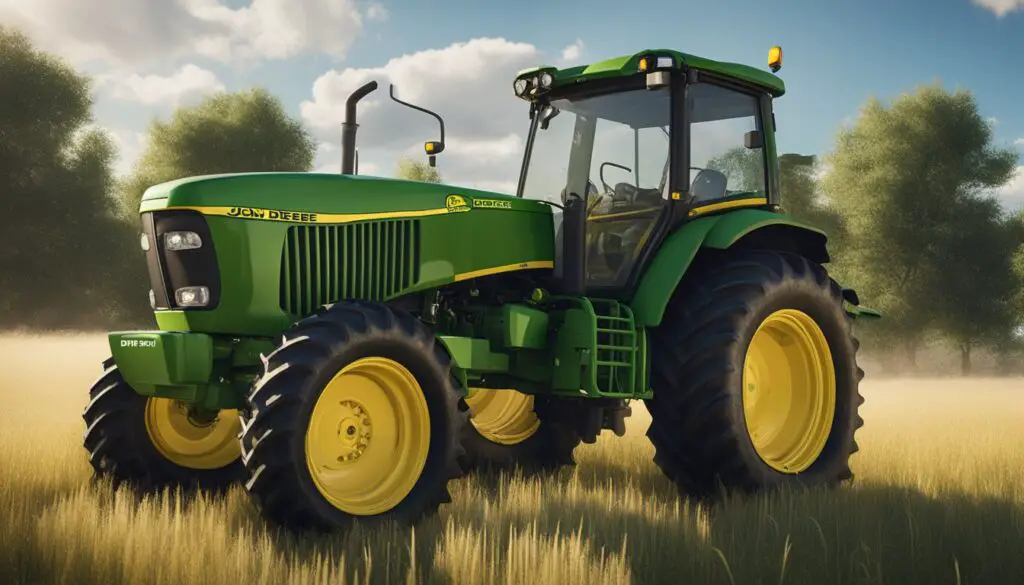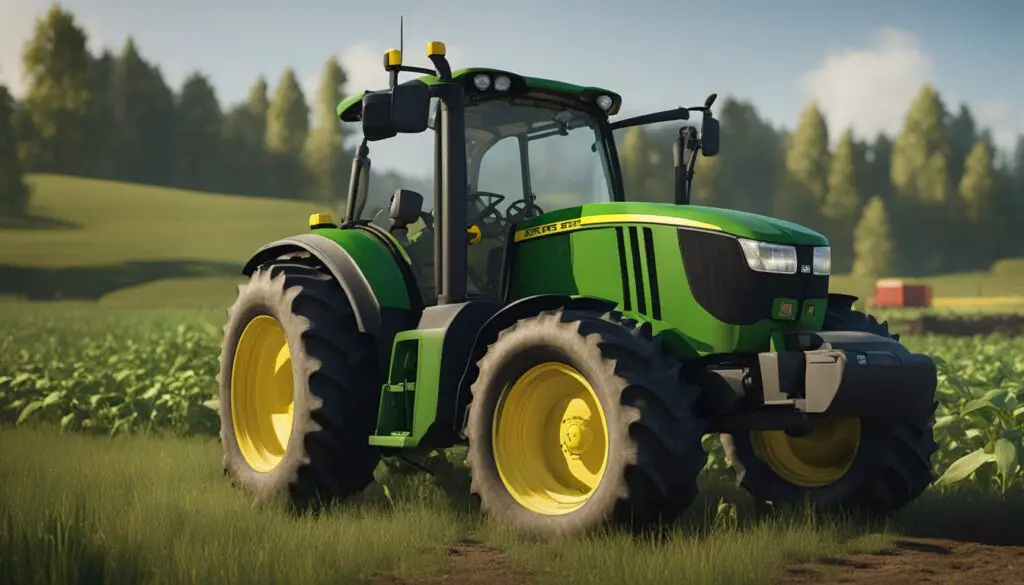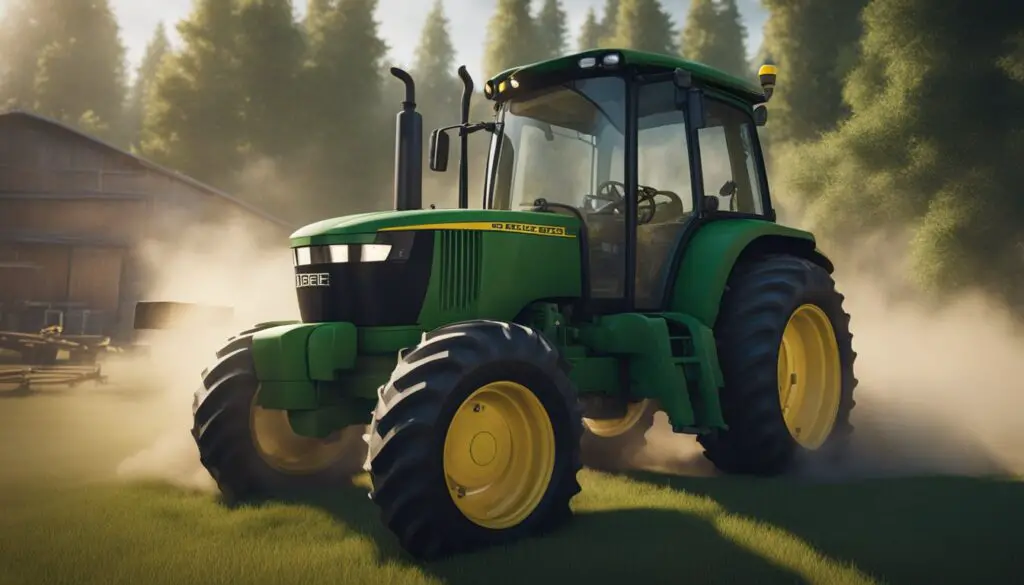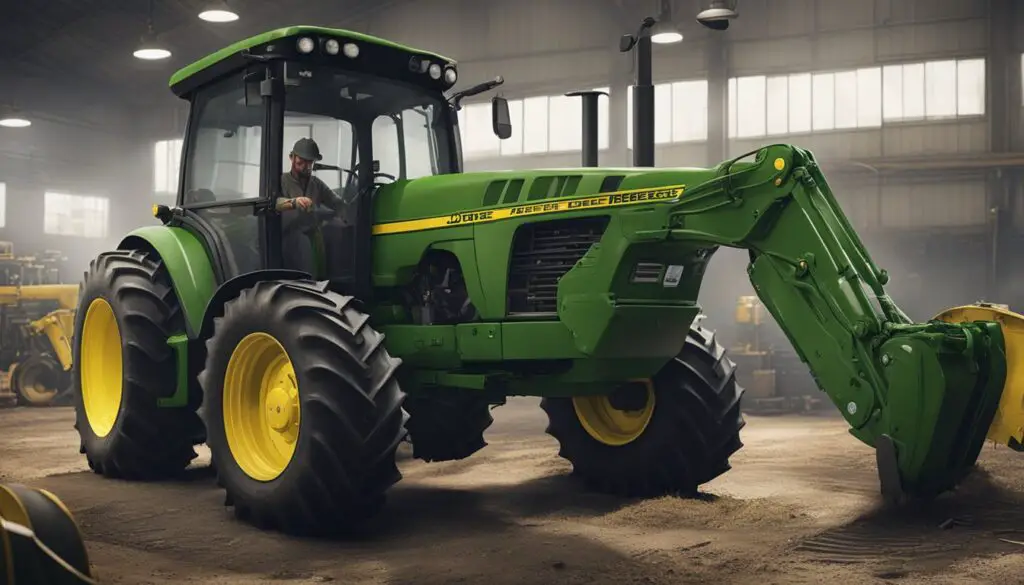The John Deere 5055E model is well-known for its durable design and impressive capabilities, suitable for a range of agricultural tasks. Equipped with a turbocharged diesel engine, hydrostatic power steering, and the ability to handle a significant amount of weight, this tractor is designed to be a reliable workhorse on the farm. Despite its strengths, owners may encounter several common issues that can affect its operation, from engine overheating to hydraulic and transmission problems.

Being familiar with these challenges is crucial for effective management and maintenance of your John Deere 5055E. Prompt addressing of such issues not only ensures a smoother operation but also helps in extending the longevity of your tractor. Good maintenance practices, coupled with an understanding of troubleshooting techniques, can mitigate many of these problems before they escalate into more serious concerns.
Key Takeaways
- Understanding common John Deere 5055E problems is essential for maintaining its operation.
- Regular maintenance is key to preventing many issues and prolonging the tractor’s life.
- Accessing the right diagnostic tools and resources simplifies troubleshooting tasks.
Overview of John Deere 5055E

The John Deere 5055E is a utility tractor that combines robust power and versatility to meet your agricultural needs. Its 55 horsepower engine is designed to manage a variety of farm tasks with efficiency.
Key Features and Horsepower
- Engine: At the heart of the 5055E is a 3-cylinder, turbocharged diesel motor that delivers 55 horsepower. This engine is not only capable of handling heavy loads but is also designed for performance and durability.
- Turbocharged: The addition of the turbo enhances engine efficiency and power, ensuring your tractor performs optimally under various working conditions.
Tractor Specifications
- Fuel Capacity: Your tractor comes with an 18-gallon (68.1 L) fuel tank to keep it running longer between refuels.
- Hydraulic System Capacity: It features a 10.3-gallon (39.0 L) hydraulic system, ensuring adequate fluid for smooth operation of hydraulic attachments.
- Front Axle and Hubs: The 5055E front axle holds 4.8 quarts (4.5 L) and each front hub has a capacity of 0.85 quarts (0.8 L), designed for durability and reduced maintenance.
- Hydraulics Flow: With pump flow at 11.4 gpm (43.1 lpm) and total flow at 18.2 gpm (68.9 lpm), your tractor ensures efficient operation of the hydraulic system, including any implements attached.
- Pricing: Originally, the 5055E could be purchased for $26,685 with a 9-speed ROPS in 2014, and $36,045 for a 12-speed version featuring a Cab, reflecting its value for a range of agricultural tasks.
Common Problems and Troubleshooting
If you own a John Deere 5055e, being aware of potential issues and how to solve them will keep your tractor running smoothly. Below, you’ll find common challenges and steps for troubleshooting them.
Starting Issues
Your 5055e may experience starting difficulties due to a faulty starter or solenoid. A quick check with a voltmeter can determine if there’s a voltage drop. To fix this, ensure the battery is fully charged, and the battery terminals are clean and secure.
Electrical Complications
Check the fuses first if you encounter any electrical issues. A blown fuse can lead to a sudden loss of power or non-functioning lights. If fuses are intact, use a voltmeter to check for continuity and look for any loose connections or damaged wires.
Overheating Challenges
Overheating can occur due to problems with the cooling system or a clogged radiator. Ensure that the coolant level is adequate and that the air filter isn’t obstructed. Regular maintenance of the cooling system can prevent overheating issues.
Fuel-Related Concerns
If the engine emits white smoke or struggles with performance, fuel problems may be to blame. This includes contaminated fuel or issues with the electric fuel pump or injection pump. Address this by inspecting the fuel lines and cleaning the fuel filter.
Hydraulic System Difficulties
Hydraulic problems can manifest as a loss of pressure or a malfunctioning steering cylinder. Ensure the hydraulic fluid is at the right level and the erased ball bearings are not worn out. Consult your tractor’s manual for proper hydraulic system maintenance instructions.
Power Take-Off (PTO) Complications
The PTO disengages or fails to engage properly when there is a complication within the system. This could be due to a failing clutch or worn piston ring. Inspect the PTO clutch for wear and tear and consider replacing it if necessary.
Transmission and Steering Issues
A common transmission issue is the failure of the power reverser, which can be caused by cold conditions or defective sensors. If you notice steering issues, it could be due to a malfunctioning power steering pump or front axle cracks. Make sure to warm up the tractor before use in cold weather and regularly inspect the steering components for damage.
Maintenance and Preventative Care
Maintaining your John Deere 5055e is crucial for optimal performance and longevity. Routine checks and proper care can prevent costly repairs and ensure that your tractor is ready for a variety of agricultural tasks.
Regular Maintenance and Inspections
Regular maintenance is the foundation of keeping your John Deere 5055e in tip-top shape. Start by checking your oil level and air intake system every 50 hours of use. Refer to your operator’s manual for specific inspection intervals and stick to a schedule.
- Checklist for Regular Inspections:
- Engine oil and filter
- Air cleaner elements
- Coolant level
- Fuel system components
- Hydraulic fluid and connections
Cooling System Maintenance
Your tractor’s cooling system is key in preventing overheating and ensuring efficient combustion. Maintain resistance to high temperatures by inspecting the radiator and checking coolant levels regularly.
- To Do:
- Inspect radiator fins and clean debris
- Verify coolant level and top off as needed
- Replace coolant as per the manufacturer’s guidelines
Fuel System Upkeep
The health of your fuel system impacts the tractor’s power and efficiency. Use the correct fuel type recommended by John Deere, and replace your fuel filter routinely to avoid buildup that can clog the system.
- Key Actions:
- Drain water from the fuel tank and sediment bowl
- Replace fuel filters annually or as necessary
- Use clean, high-quality diesel fuel
Hydraulic System Care
A well-maintained hydraulic system ensures smooth operation of attachments and implements. Regularly check the hydraulic fluid level, and inspect all hydraulic connections for leaks.
- Hydraulic Maintenance Tips:
- Monitor fluid levels before each use
- Change the hydraulic filter as indicated by service intervals
- Look for signs of leaks or wear in hydraulic hoses
Transmission and Clutch Adjustments
Proper lubrication and adjustment of your transmission and clutch can greatly reduce the risk of malfunction. Regular maintenance can also help you identify issues before they lead to failure.
- Maintenance Essentials:
- Ensure transmission fluid is at the proper level
- Adjust clutch linkage as necessary for smooth operation
- Lubricate transmission and clutch components according to the service schedule
By adhering to these maintenance practices, you can greatly reduce the likelihood of encountering common issues with your tractor and enhance its performance for all the agricultural tasks ahead.
Cost and Value Considerations

When evaluating the John Deere 5055E tractor, consider the balance between cost and value, especially for agricultural tasks and utility tractor needs. This tractor, appreciated for its versatility, is an investment in efficiency and performance.
Cost of Purchase: Pricing for the John Deere 5055E may vary based on the dealer, location, and included features or attachments. It’s essential to get a quote from a local dealer and compare it to your budget and financial plans.
Fuel Efficiency: An integral aspect is its fuel efficiency. The John Deere 5055E is designed to provide a balance between power and fuel economy, reducing long-term operational costs.
Versatility and Attachments:
- The 5055E’s ability to work with a range of attachments adds exceptional value.
- You can easily expand its utility with mower decks, loaders, or plows.
| Attachment | Utility | Value Added |
|---|---|---|
| Mower Decks | Grass cutting | High |
| Loaders | Material handling | Significant |
| Plows | Soil preparation | Considerable |
Maintenance Costs: Like any machine, the 5055E will incur maintenance costs. Regular maintenance can help avoid more significant, costly repairs and extend the tractor’s lifespan. Therefore, factor maintenance into the total cost of ownership.
Remember that while upfront costs can be substantial, the efficiency and capabilities of the John Deere 5055E tractor might offer savings over time, making it a potentially wise investment for your farming needs.
Diagnostic Tools and Resources

When your John Deere 5055e encounters issues, having the right diagnostic tools and a clear understanding of how to use them can make troubleshooting much simpler. Here’s how you can harness these resources to pinpoint and resolve problems efficiently.
Using a Voltmeter
A voltmeter is essential for testing electrical components. To check the health of your tractor’s battery and alternator:
- Set your voltmeter to the voltage setting.
- Connect the positive lead to the battery’s positive terminal and the negative lead to the negative terminal.
- A healthy battery should read around 12.6 volts. Significantly lower readings could indicate a faulty battery or alternator, or issues with relays and fuses.
To diagnose starter or solenoid troubles:
- Place the voltmeter’s leads on the respective terminals of the starter or solenoid. Low or no voltage could signify a problem in these components.
Checking Hydraulic Fluid Levels
Proper hydraulic fluid levels are key to smooth operation of your tractor’s 3-point hitch and power take-off (PTO). Closely inspecting hydraulic fluid levels and condition can help you prevent or address hydraulic issues.
- Hydraulic Fluid Check:
- Turn off the tractor and let it cool.
- Locate the hydraulic fluid dipstick and clean it before inserting it back to get an accurate reading.
- If the fluid level is low, replenish it with the recommended hydraulic fluid type.
Beware of leaks from hoses and fittings and address them immediately to avoid further hydraulic system complications.
Reading Diagnostic Codes
Newer John Deere models may have onboard diagnostics that can generate error codes related to the tractor’s systems, helping in identifying PTO problems , fuel flow issues, or sensor malfunctions.
- Diagnostic Code Retrieval:
- Sit in the operator’s seat and turn the ignition key to the “on” position without starting the engine.
- Observe the instrument panel for blinking lights that correspond to error codes.
For detailed interpretations of diagnostic codes, refer to your John Deere 5055e’s operator’s manual or consult with a professional technician for accurate troubleshooting. Remember, catching problems early by observing abnormal behavior in your tractor’s operation, such as unexpected fuel gauge readings or an unresponsive 3-point hitch, can save time and prevent serious damage.
Handling Specific Malfunctions

When your John Deere 5055e tractor encounters malfunctions, addressing them promptly ensures the machine maintains optimal performance. Here’s how you can deal with some of the specific issues your tractor may face.
Resolving Overheating
Ensure your radiator is free from debris, and check that the coolant levels are adequate. A malfunctioning fan belt or a clogged charge air cooler (CAC) can also lead to overheating. Regular maintenance, including cleaning the radiator and replacing the coolant, can prevent overheating issues.
Rectifying Electrical Issues
Electrical issues often stem from faults in fuses, relays, or the electric fuel pump. Check for any burned-out fuses and replace them. If you’re experiencing a sudden loss of power, inspect the relays and voltage drop across the electrical system. Keeping electrical connections secure is crucial for avoiding these problems.
Addressing PTO Malfunctions
If your Power Take-Off (PTO) disengages unexpectedly, inspect the PTO clutch and its related connections for wear or damage. Also, confirm the hydraulic system is functioning correctly, as it plays a crucial role in the PTO’s performance.
Fixing Hydraulic Leakages
Hydraulic issues may cause the steering to feel unresponsive. Regularly inspect hydraulic connections for leaks and ensure the hydraulic fluid is at the required level. Replacing any worn-out piston rings or gaskets can also correct leakage issues. Proper maintenance of the hydraulic system will enhance fuel efficiency and overall tractor performance.
Dealing with Steering Challenges
Steering wheel problems can arise from a lack of hydraulic fluid or a steering cylinder malfunction. Check the steering pump and cylinder for any damage. Regularly maintaining the power steering system, including checking for fluid leaks and refilling as necessary, can help avoid steering challenges.
Improving Tractor Longevity

To get the most out of your John Deere 5055e tractor and reduce the occurrence of common problems, certain practices are essential. These include the right usage techniques, engine care strategies, and regular maintenance.
Optimal Usage Practices
Your tractor is a versatile tool, and using it correctly is crucial for longevity. Ensure that you’re operating the tractor within its recommended capacity and using attachments as intended. Maintain a steady pace when conducting agricultural tasks to promote fuel efficiency and lessen the strain on the engine and hydraulic systems.
- Usage Checklist:
- Operate within weight capacity: up to 3192lbs
- Regularly check fluid levels
- Use attachments correctly to prevent undue stress
Strategies for Prolonging Engine Life
The diesel motor of your John Deere 5055e is the heart of its operations. To prevent common diesel motor problems, it’s imperative to practice good engine habits. Keep your engine clean from debris and ensure proper lubrication. Utilize the right type of fuel and execute troubleshooting steps, such as checking for proper flow if you experience a sudden loss of power.
- Engine Protection Tips:
- Keep the engine clean from dirt and debris
- Ensure proper lubrication according to schedule
- Use high-quality diesel to maintain fuel efficiency
Preventive Maintenance Scheduling
Regular maintenance is your first line of defense in preventing hydraulic system problems and maintaining the utility of your tractor. Stick to the manufacturer’s suggested maintenance schedule, and don’t hesitate to perform troubleshooting when minor issues arise. Check and replace filters and fluids regularly, and address any unusual noises or decreases in power immediately.
- Maintenance Calendar Highlights:
- Replace filters and check fluid levels routinely
- Follow the prescribed schedule for oil changes and lubrication
- Conduct regular inspections of attachments and hydraulic lines
By adhering to these guidelines, you can significantly improve the lifespan and performance of your John Deere 5055e tractor.
Upgrade and Customization Options
When you own a John Deere 5055e tractor, upgrading and customizing it can boost its performance and adaptability to your specific needs. Here are some popular ways to jazz up your machine.
Adding Attachments
Your John Deere 5055e becomes even more versatile with the right attachments. Depending on your tasks, you can augment your tractor with mower decks, loader buckets, or bale spears. These attachments utilize the tractor’s 3-point hitch and hydraulic system, allowing for quick changes between implements. However, be mindful of potential hydraulic issues – regular maintenance can prevent most problems.
- Attachments for Fieldwork:
- Ploughs
- Seeders
- Sprayers
- Attachments for Landscaping:
- Lawn mowers
- Snow blowers
- Front loaders
Engine and Power Modifications
To enhance your tractor’s fuel efficiency and overall performance, you can modify the engine. Solutions like upgrading the air intake with clean and unobstructed radiator fins can improve combustion. Addressing common issues such as replacing worn piston rings and ensuring the gasket seals properly will keep your engine running smoothly and prevent loss of power.
- Performance Mods:
- High-flow air filters
- Performance-tuned exhaust
Accessorizing for Comfort and Efficiency
Long hours on the tractor can take a toll, so consider accessorizing for comfort and efficiency. Installing a weather canopy or an ergonomic seat can make your workday more pleasant. If you’re working on tougher terrain, strengthening the front axle can prevent cracks and contribute to the 4WD capability, ensuring that your tractor remains a faithful workhorse.
- Comfort Add-ons:
- Cushioned seats
- Cab climate control
- Efficiency Upgrades:
- LED lighting
- Advanced instrument panels
Remember, upgrades can lead to increased costs, so balance your desires for enhancement with your budget. Each modification should serve a purpose, whether it’s to improve the tractor’s performance or to make your work easier and more enjoyable.
Frequently Asked Questions
In this section, we address some of the most commonly encountered issues with the John Deere 5055E and provide insights on troubleshooting and maintenance.
What are common electrical issues in the John Deere 5055E?
Your John Deere 5055E tractor may sometimes face electrical challenges, such as a sudden loss of power. Often, this can be traced to problems with the relays or fuses, so checking these components should be your first step.
How does one troubleshoot transmission problems in a John Deere 5055E?
If you’re experiencing transmission problems, it’s essential to check the fluid levels first. Insufficient or contaminated transmission fluid can lead to shifting difficulties and should be addressed promptly.
What should I check for when experiencing hydraulic issues on my John Deere 5055E?
Hydraulic issues typically manifest as weak or slow hydraulic operations. Start by checking the hydraulic fluid level and quality, and ensure that there are no leaks or blockages in the system.
Are there any recurring engine problems with the John Deere 5055E model?
Engine overheating is a recurring issue with the John Deere 5055E. To prevent this, regularly clean the radiator and check for any obstructions, as well as monitor coolant levels and replace old fluids as needed.
How can steering difficulties in the John Deere 5055E be resolved?
Steering difficulties might arise due to inadequate hydraulic fluid or air trapped in the steering system. Make sure the hydraulic fluid is at the proper level and bleed the system if necessary.
What maintenance tips are there to avoid common issues with the John Deere 5055E?
Regular maintenance is key to preventing common issues. This includes checking fluid levels, cleaning filters, and inspecting for any signs of wear or damage. Adhere to the manufacturer’s recommended service intervals to keep your tractor running smoothly.

Leave a Reply